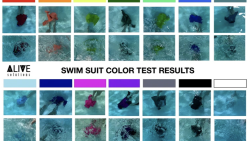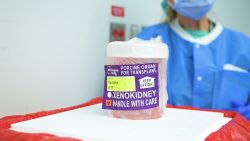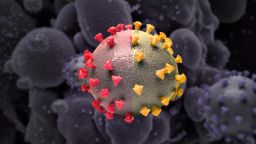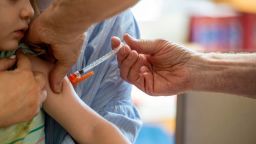When Amber Sizemore and her family went out of state to celebrate her birthday last week, she had hoped her toddler daughter, Raegan, would try swimming. But the 15-month-old, normally energetic and adventurous, wasn’t herself on Saturday.
“She hated it, and she normally loves water,” Sizemore said.
By Sunday, when the family was heading back to Ohio, the little girl was “coughing like crazy.”
“She coughed so hard, she threw up,” Sizemore said. Raegan also stopped eating and developed a fever.
When Tylenol didn’t help, Sizemore took her to urgent care and told them that RSV or respiratory syncytial virus, a common cold-like virus, was going around at Raegan’s day care, where Sizemore also works.
The test came back positive, and Raegan’s vital signs prompted the staffers at the urgent care to tell Sizemore to take her daughter to the hospital.
As soon as they saw her vitals, the staff at UH Rainbow Babies & Children’s Hospital in Cleveland knew they had to admit Raegan, her mom said. She needed oxygen.
“They’ve been great here and taken good care of her, but the scariest part is, had I not already known she was exposed to RSV, I may have just let her cough it out,” Sizemore said. “I’m glad I didn’t wait.”
Most kids catch RSV at some point before they turn 2, the US Centers for Disease Control and Prevention says, and it’s usually mild. Symptoms may look like a common cold and include runny nose, decreased appetite, coughing, sneezing, fever and wheezing. They typically last a week or two, and clear up with rest and fluids.
But in some children, especially young infants, RSV can be dangerous, leading to dehydration, breathing trouble and more serious illnesses such as bronchiolitis or pneumonia.
Now, there’s an “unprecedented” rise in RSV cases among children in the US, some doctors tell CNN.
The CDC does not track hospitalizations or deaths for RSV like it does for flu, but it said Thursday there has been a rise in RSV cases in many parts of the country. Several children’s hospitals told CNN that they’ve been “overwhelmed” with patients at a time of the year when it’s unusual to have a surge of RSV patients.
Overall, pediatric hospital beds are more full now than they’ve been in the past two years, according to federal data.
The US Department of Health and Human Services does not specify the reason for hospitalization, but about three-quarters of pediatric hospital beds available nationwide are being used now. By comparison, pediatric hospital beds were about two-thirds full on an average day over the past two years.
‘Never seen this level of surge’
With the RSV surge, UH Rainbow Babies has had so many patients, it went on diversion for a couple of days in early October, meaning it couldn’t take external emergency admissions. It’s taking patients again now, but it’s still slammed with RSV cases.
There has been such such a dramatic increase in cases in Connecticut that Connecticut Children’s Hospital has been coordinating with the governor and public health commissioner to determine whether it should bring the National Guard in to expand its capacity to care for these young patients.
“I’ve been doing this a long time. I’ve been at Connecticut Children’s for 25 years, and I’ve never seen this level of surge specifically for RSV coming into our hospital,” Dr. Juan Salazar, the hospital’s executive vice president and physician in chief, told CNN.
In Texas, where RSV cases usually spike in December or January, the emergency department at Cook Children’s in Fort Worth and its urgent cares are seeing a significant number of RSV cases. Nearly half the ICU is filled with RSV cases, hospital spokesperson Kim Brown said; between October 2 and 8, there were 210 RSV cases at Cook Children’s; a week later, there were 288.
Jeff and Zoey Green’s 4-month-old, Lindy, was admitted to Cook on Sunday.
At the hospital, Lindy’s fever was so high at one point they said they used ice packs to cool her down.
“I don’t know how but she slept with those ice packs on top of her,” Zoey Green said, holding an exhausted Lindy at the hospital. She said they’re trying to keep her hydrated so she doesn’t have to go back on an IV.
“We want her to be better, for sure.”
Dr. Mallory Davis, an infection preventionist at Helen DeVos Children’s Hospital in Grand Rapids, Michigan, is also seeing an early surge.
“We are very full, and our census numbers are pretty high as we work through kind of figuring out how to accommodate all of the sick kiddos in the community,” she said.
Children’s Hospital Colorado has seen an early uptick in RSV hospitalizations and is starting to see the first few flu cases of the season, said Dr. Kevin Messacar, an infectious disease specialist and associate professor at the University of Colorado School of Medicine.
“We have been seeing increased patient volumes since the late summer, which started with rhinoviruses and enteroviruses as children returned to school, and now is being driven by RSV and parainfluenza,” he said. “With influenza season rapidly approaching with what appears to be an early start, we are concerned about the persistently increased volumes of sick children requiring hospitalization.”
At UH Rainbow Babies, staff are hoping things don’t get much worse. “I mean, I hope we’re peaking right now, because if we’re not, then holy hell,” said Dr. Amy Edwards, associate medical director for pediatric infection control.
RSV cases can often fill hospitals, even in regular seasons, since there aren’t many treatments and it can require several days of supportive care in severe cases, Edwards said.
Ill children “need that oxygen support, so they can’t be at home,” she said.
Experts think US cases may be spiking now because of the phase of the Covid-19 pandemic that we’re in.
When everyone stayed home in 2020 and 2021 to prevent the spread of the coronavirus, it seemed to change the typical RSV season. Case counts were low, and that created an “immunity gap.”
Kids who normally would have caught the virus in those years are instead catching it now.
Who’s vulnerable to RSV
The CDC says most kids will catch RSV at some point before they turn 2. It’s a highly contagious virus that often doesn’t cause serious illness, except in adults who are elderly or have chronic heart or lung disease or a weakened immune system, and in some infants and children.
There’s no specific treatment for RSV and no vaccine. The symptoms usually last a week or two and clear up with plenty of fluids and rest.
For some kids, though, it can be a much more serious disease. RSV can be especially dangerous for preemies, newborns, children with weakened immune systems or neuromuscular disorders, and those under age 2 with chronic lung and heart conditions, the CDC says.
RSV can turn into bronchiolitis, in which the small airways can become inflamed and congested, or pneumonia. A child may need to stay in the hospital so they can get extra oxygen or even mechanical ventilation to help them breathe.
How RSV spreads
An infected person can pass on RSV through a cough or sneeze. If the respiratory droplets land on a surface like a doorknob or desk and someone else touches it and then touches their face, they can get sick.
RSV symptoms
Symptoms include:
It’s generally such a mild illness that adults often don’t realize they have it, or they think it’s nothing more than a cold or allergies and go on to interact with others.
“It’s not a fatiguing virus the way influenza or Covid is, so you really do feel fine,” Edwards said. “And then what happens is, your neighbor has that beautiful baby, and you bring over a casserole, and you kiss that little baby because you feel fine. You don’t feel sick. And unfortunately, you pass it on to them, and sometimes they end up at the hospital.”
Older siblings can also pass the virus along to younger ones.
“Babies slobber on toys and on each other and everything else, so day cares pass it along, too,” Edwards said.
If your child is coughing or lethargic, or if they just don’t seem like themselves, it’s a good idea to take them to their pediatrician. The doctor’s office will have the tests to figure out if it’s RSV, the flu, Covid-19 or strep.
Pediatricians say a trip to the ER may be necessary if a baby is dehydrated; if they have difficult, labored, shallow or rapid breathing; if they have a high fever or bluish skin; or if they become unresponsive. The CDC says most improve with supportive care and can often go home after a few days.
How to prevent RSV
The best ways to prevent RSV infections, doctors say, is to teach kids to cough and sneeze into a tissue or into their elbows rather than their hands. Also try to keep frequently touched surfaces clean.
“Hand hygiene is the single most important thing that we can do to keep ourselves and others safe,” said Davis, of the children’s hospital in Grand Rapids. She tells people to never touch their faces unless they recently washed their hands.
Get CNN Health's weekly newsletter
- Sign up here to get The Results Are In with Dr. Sanjay Gupta every Friday from the CNN Health team.
When kids or grownups are sick, they need to do one thing and one thing only, she said: “Stay home when you are sick so you won’t spread whatever respiratory illness you have.”
Sizemore, whose daughter is still in the hospital with RSV but seems to be getting better, also advises people to take the virus seriously.
“I would like other parents to know they shouldn’t watch their child’s cough lightly and take symptoms seriously,” she said. “This could have been a much worse situation if we didn’t get Raegan help.”
CNN’s Brenda Goodman, Jamie Gumbrecht, Deidre McPhillips and Chris Boyette contributed to this report.


























